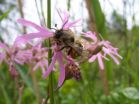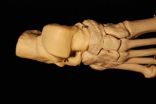(Press-News.org) Three of the world's subspecies of tigers are now extinct. A new study found that the Sumatran tiger subspecies is nearing extinction as a result of human activities, particularly the conversion of natural forests into forestry and agricultural plantations, leading to habitat loss.
The study, conducted by Virginia Tech and World Wildlife Fund (WWF), is the first of its kind to systematically investigate the use of different land cover types — not just forests but also plantation areas — for tiger habitat.
Published in the Public Library of Science's online journal PLoS ONE on Jan. 23, the study was led by Sunarto, who earned his doctorate in wildlife sciences from Virginia Tech in 2011. The study was a collaboration between the university and WWF, and received support from the Indonesian Ministry of Forestry.
The authors found that Sumatran tigers strongly prefer forests over plantations of acacia and oil palm trees and tend to avoid plantation areas unless they contain thick ground-level vegetation and have extremely low levels of human activities.
Within forest areas, tigers also strongly prefer sites that have low levels of human disturbance as indicated by their preference for areas closer to forest centers and farther from human activity centers such as bodies of water and forest edges.
The most notable find, however, was the tigers' strong predilection for sites with understory cover — vegetation cover at the ground level — which suggests that the availability of adequate understory cover serves as an environmental necessity for tiger habitat, regardless of location.
"As ambush hunters, tigers would find it hard to capture their prey without adequate understory cover," said Sunarto, who is now a tiger expert for WWF–Indonesia. "The lack of cover also leaves tigers vulnerable to persecution by humans, who generally perceive them as dangerous."
While the Indonesian government has set aside many areas and national parks for the conservation of endangered species, about 70 percent of tiger habitat in Sumatra remains outside these protected areas. The preservation of such habitats, which requires support from government, landowners, and concession holders, is critical for the conservation of the species, the study authors emphasize.
"Even with current legal protection for the species, tigers are not doing well in many places, especially those outside protected areas," Sunarto said. "As long as forest conversion continues, tigers will require active protection or they will quickly disappear from our planet."
"These results indicate that to thrive, tigers depend on the existence of large contiguous forest blocks," said study co-author Marcella Kelly (http://www.mjkelly.info/), an associate professor in Virginia Tech's Department of Fish and Wildlife Conservation and Sunarto's graduate advisor.
The study concludes that in order to protect tigers, it is critical to stop the clearing of Indonesia's remaining natural forests for plantations. With adjustments in management practices in existing plantations to include more understory and riparian forest corridors, tigers could use a mosaic of forest patches across fragmented landscapes.
"We hope that plantation managers and concession owners can use the recommendations of this report to apply best management practices to further protect Sumatran tigers from extinction," said Anwar Purwoto, director of the Forest, Freshwater, and Species Program at WWF¬Indonesia.
A recently published Indonesian presidential decree on land use in Sumatra plan points out the importance of building wildlife corridors between critical areas, where commitments from concession owners are key to successful implementation.
"Ensuring that tigers are able to roam freely in natural forests and restored habitat is crucial to their survival," said co-author Sybille Klenzendorf, head of WWF's species program, who earned her master's and doctorate degrees in wildlife science from Virginia Tech. "This study is a reminder of just how important it is for us to protect the natural forests that tigers and other animals rely on."
Tigers occupy only around 7 percent of their historic range. There are estimated to be as few as 3,200 tigers left in the wild, and fewer than 400 Sumatran tigers, which are listed as critically endangered on the International Union for Conservation of Nature Red List of Threatened Species.
INFORMATION:
The PLoS One study is online at http://www.plosone.org/article/info%3Adoi%2F10.1371%2Fjournal.pone.0030859
Nowhere to hide: Study finds future of Sumatran tigers threatened by human disturbances
2012-03-01
ELSE PRESS RELEASES FROM THIS DATE:
Researchers find safer way to use common but potentially dangerous medication
2012-03-01
SALT LAKE CITY — A team of global scientists, led by researchers at Intermountain Medical Center in Salt Lake City, has developed a safer and more accurate way to administer warfarin, one of the most commonly prescribed but also potentially dangerous medications in the United States.
As part of a worldwide study, the research team developed and tested a new formula that combines individual genetic data with a mathematical model to help physicians more accurately predict patient response to the popular blood-thinning drug.
Researchers found that the formula was safer ...
DES Linked to Serious Health Issues for Multiple Generations
2012-03-01
For more than four decades, a drug called diethylstilbestrol (DES) was prescribed to millions of expecting mothers in an effort to prevent miscarriages. Prescriptions for the drug were written until 1971, when researchers discovered a link between prenatal exposure to DES and the development of reproductive tract cancers. Notably, researchers discovered health issues of developing breast cancer not only in the expecting mothers themselves, but also in their daughters decades later after being exposed to DES in utero. These victims have come to be known as the DES daughters.
As ...
Is Twitter reinforcing negative perceptions of epilepsy?
2012-03-01
New York, February 29, 2012 – A revealing study published in Epilepsy & Behavior provides evidence that the perception of epilepsy is not faring well in social media. Kate McNeil and colleagues from Dalhousie University in Canada analyzed data collected from Twitter to provide a snapshot of how epilepsy is portrayed within the twitter community.
Twitter, a social networking platform launched in 2006, allows its users to communicate through posting of "tweets" limited to 140 characters. Twitter has gained worldwide popularity since its inception, with approximately 110 ...
Heavy metal pollution causes severe declines in wild bees
2012-03-01
Wild bees are important pollinators and numerous studies dealing with pollination of wild plants and crops underline their vital role in ecosystems functioning. While honey bees can be easily transported to various location when needed, wild bees' presence is dependent on the availability of high quality semi-natural habitats. Some crops, such as apples and cherries, and many wild flowers are more effectively pollinated by wild bees and other insects rather than managed honey bees.
Although heavy metal pollution is recognized to be a problem affecting large parts of the ...
Ultrasound technology proves accurate in diagnosing cirrhosis from recurrent hepatitis C
2012-03-01
Researchers from the Mayo Clinic confirm that ultrasound-based transient elastography (TE) provides excellent diagnostic accuracy for detecting cirrhosis due to recurrent infection with hepatitis C virus (HCV) infection following liver transplantation. Findings from the study published in the March issue of Liver Transplantation, a journal of the American Association for the Study of Liver Diseases, suggest that detection of significant fibrosis is more accurate when comparing patients with chronic HCV of the native liver.
According to the World Health Organization (WHO), ...
Foot bones allow researchers to determine sex of skeletal remains
2012-03-01
Law enforcement officials who are tasked with identifying a body based on partial skeletal remains have a new tool at their disposal. A new paper from North Carolina State University researchers details how to determine the biological sex of skeletal remains based solely on measurements of the seven tarsal bones in the feet.
"Tarsals are fairly dense bones, and can be more durable than other bones – such as the pelvis – that are used to determine biological sex," says Dr. Troy Case, an associate professor of anthropology at NC State and co-author of a paper describing ...
Choosing Assisted Living: Pros, Cons & Liability Issues
2012-03-01
As the baby boomer generation grows older, decisions related to selling the family home and moving, in order to provide aging family members with additional care, will become increasingly important for many American families. For some, this decision will focus on two alternative housing options in particular: assisted living facilities and nursing homes. There are advantages and disadvantages to both types of housing, though both are governed by sets of laws that protect residents and ensure their proper care.
Nursing homes have gained a bad reputation over the past ...
Gluten-free, casein-free diet may help some children with autism
2012-03-01
A gluten-free, casein-free diet may lead to improvements in behavior and physiological symptoms in some children diagnosed with an autism spectrum disorder (ASD), according to researchers at Penn State. The research is the first to use survey data from parents to document the effectiveness of a gluten-free, casein-free diet on children with ASD.
"Research has shown that children with ASD commonly have GI [gastrointestinal] symptoms," said Christine Pennesi, medical student at Penn State College of Medicine. "Notably, a greater proportion of our study population reported ...
South Texas Oil and Gas Boom Means More Tanker Traffic
2012-03-01
Already a prominent oil and gas state, Texas can expect its contribution to the nation's energy resources to keep growing. Take the Barnett Shale formation, for instance, near Fort Worth. The Barnett Shale already produces six percent of all natural gas produced in the entire 48 contiguous states, with more production expected.
Texas Shale Formations & Hydraulic Fracturing
Extracting trapped natural gas from the reservoirs of layered shale rock has, for the first time in just the last several years, become practical and profitable.
Conventional drilling equipment ...
Exotic material boosts electromagnetism safely
2012-03-01
DURHAM, N.C. -- Using exotic man-made materials, scientists from Duke University and Boston College believe they can greatly enhance the forces of electromagnetism (EM), one of the four fundamental forces of nature, without harming living beings or damaging electrical equipment.
This theoretical finding could have broad implications for such applications as magnetic levitation trains, which ride inches above the tracks without touching and are propelled by electro-magnets.
As the term indicates, EM is made up of two types of fields – electric and magnetic. Alternating ...



